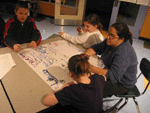Activity:
Planning Interviewing Strategies
Objectives:
- To conduct
interviews with people in the neighborhood
to get relevant information for the project
- To help participants
learn interviewing skills
Materials:
Pen, pencils, paper, notebooks and digital
camera (preferably) Duration:
1 – 3 hours |

Interview Planning, Charlestown Computer Clubhouse,
Boston |
Procedure:
- As a first
step, a script has to be created by the participants
and facilitators together. The script should
contain questions related to the most important
social issues. The basis for the questions
should be ‘who, when, where and how’.
- The facilitator
should identify in advance some people in
the community who are supportive of the idea
of children’s participation and would
welcome an interview with them
- The participants
define their roles for interviewing –
1. Who will interview the people identified
for the interview in the community?
2. Who will take down notes while another
participant is interviewing?
3. Who will take pictures with the camera?
4. Who will establish where they are going?
For example, identifying the streets, local
areas and organizations.
- The facilitator
oversees and co-ordinates the interviewing
strategies of the participants
Comments:
If there is a big group of participants (more
than 6), they should work in smaller groups.
A good way to achieve confidence in interviewing
is to have small groups of children design questions
and practice asking them of other children.
This method might seem suitable only for older
participants, but there are a variety of ways
to use interviewing with participants of many
ages, including those who are not literate.
For participants with limited writing abilities,
using a tape recorder in the interview enables
them to obtain a complete record.
Analysis of the
interview data can happen either in the same
interview session or in the next session.
Notes
from the Field: In the YAN project
at Charlestown Computer Clubhouse, two social
issues (drunk driving and garbage disposal)
were chosen as a result of the neighborhood
perception form activity. So the participants
decided to analyze the importance of the issues
by conducting interviews in the community. As
a result of the interviews, garbage disposal
proved to be the more important issue, which
was then chosen for the project.
|